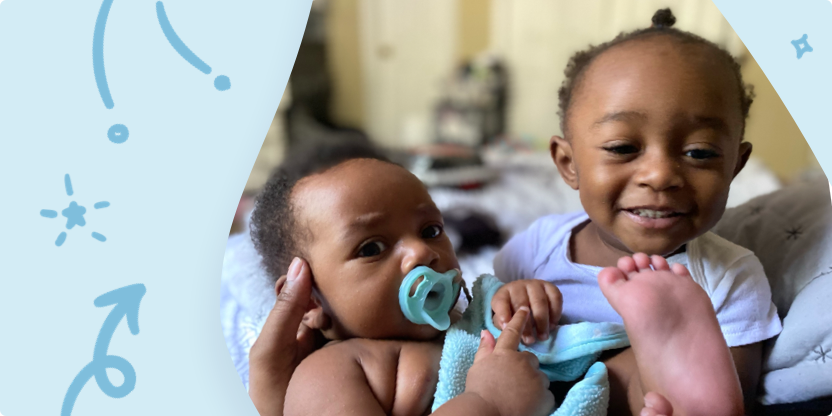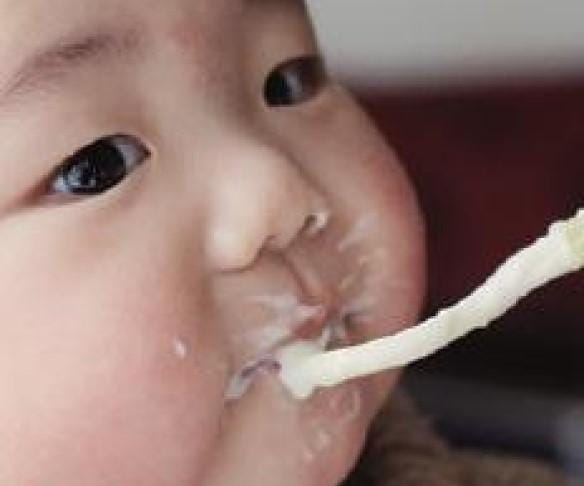

Knowing When to Feed
Breastmilk or infant formula will remain your child’s main source of nutrition. But as you introduce iron-rich infant cereal and baby food to your Supported Sitter, there’s a new set of feeding cues to learn. Knowing when to feed is an essential part of your baby's health and development. As their eating skills improve, you’ll quickly get the message when they want to eat. Your baby is learning new skills and letting you know it.
Supported Sitter Hunger Cues:
- Cries or fusses when hungry for milk or desires food.
- Opens their mouth wide and leans toward spoon once they see it.
- May attempt to grab or swipe at spoon.
- Smiles at you during feeding as if to say, “I’m still hungry, keep it coming.”
Recognizing When They are Full
Responding when your baby is full by putting down the spoon can help set the stage for good eating habits, letting your baby recognize their own hunger and fullness cues. As a Supported Sitter, they are learning their own internal cues to eat only until satisfied. Most babies can regulate their own feeding, so you should never force them to finish the bowl.
Supported Sitter Fullness Cues:
- Stops sucking or slows down their pace and may fall off to sleep while breast- or bottle-feeding.
- Releases their latch from breast or bottle nipple.
- Keeps their mouth closed and may even cover mouth with their hands to refuse any more food.
- Spits out familiar food or turns their head away from it.
- Gets distracted and gazes around.
Formulas that Nourish Happy and Healthy Tummies
-
CLP Certified
 1st Foods®Gerber BananaSupported SitterAround 6 months
1st Foods®Gerber BananaSupported SitterAround 6 monthsStart your baby’s lifelong love of fruits and veggies with these single fruit and vegetable baby foods.
$1.491 -
CLP Certified
 1st Foods®Gerber AppleSupported SitterAround 6 months
1st Foods®Gerber AppleSupported SitterAround 6 monthsStart your baby’s lifelong love of fruits and veggies with these single fruit and vegetable baby foods.
$1.491 -
CLP Certified
 1st Foods®Gerber Sweet Potato Baby FoodSupported SitterAround 6 months
1st Foods®Gerber Sweet Potato Baby FoodSupported SitterAround 6 monthsStart your baby’s lifelong love of fruits and veggies with these single fruit and vegetable baby foods.
$1.491 -
CLP Certified
 1st Foods®Gerber PruneSupported SitterAround 6 months
1st Foods®Gerber PruneSupported SitterAround 6 monthsStart your baby’s lifelong love of fruits and veggies with these single fruit and vegetable baby foods.
$1.191 -
CLP Certified
 1st Foods®Gerber BananaSupported SitterAround 6 months
1st Foods®Gerber BananaSupported SitterAround 6 monthsClean Field Farming™ – it’s how we ensure our purees are not only nutritious, but also wholesome and safe for every tiny tummy.
$1.391 -
CLP Certified
 1st Foods®Gerber CarrotSupported SitterAround 6 months
1st Foods®Gerber CarrotSupported SitterAround 6 monthsClean Field Farming™ – it’s how we ensure our purees are not only nutritious, but also wholesome and safe for every tiny tummy.
$1.391 -
CLP Certified
 1st Foods®Gerber PearSupported SitterAround 6 months
1st Foods®Gerber PearSupported SitterAround 6 monthsStart your baby’s lifelong love of fruits and veggies with these single fruit and vegetable baby foods.
$1.491






